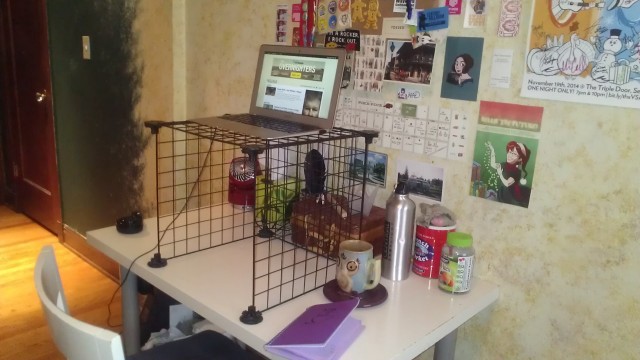Standing Desks Compensate For Overly Long Workdays

I’ll be the first to say that I love my standing desk; that on days when I am unable to stand while I work (like travel days, or days when I’m unable to work in my apartment because there is water coming out of the wall) I feel frustrated and uncomfortable, and that putting a crate on top of my regular desk and then putting my laptop on the crate was one of the best things I did for my workday.
I should also throw in that I am both able-bodied and perpetually active; my FitBit loves me, and someday I am going to challenge Nicole Cliffe of The Toast to a pushup contest. (This is only funny if you know that Cliffe posts her workouts to The Toast, and I post mine to Twitter, and I want to determine who is the strongest Nicole.)
So, yeah. Standing desk = great for me.
But what can a standing desk do for you?
According to the Washington Post, via James Levine of the Mayo Clinic, switching to a standing desk will increase your productivity by 15 percent.
It will also, in theory, improve your health — or, more accurately, reverse the negative effects of sitting. The WaPo quotes activity expert Gavin Bradley:
“Metabolism slows down 90 percent after 30 minutes of sitting. The enzymes that move the bad fat from your arteries to your muscles, where it can get burned off, slow down. The muscles in your lower body are turned off. And after two hours, good cholesterol drops 20 percent. Just getting up for five minutes is going to get things going again. These things are so simple they’re almost stupid.”
Well, my goodness. If these things are so simple, why doesn’t everybody do them? Why aren’t we all jumping up and down — literally — for this 15 percent increase in productivity and 90 percent increase in metabolism?
For starters, not all of us are capable of standing for the whopping four hours a day that the Washington Post and its experts recommend. Then there are all of the add-on “light intensity activities” that you’re supposed to do in addition to standing, such as “walking over to a colleague’s desk instead of sending an email.”
Imagine that you’re busily typing away at some report that is due later this afternoon, or putting together a spreadsheet. You suddenly get interrupted by Mx. Light Intensity Activity, walking over to ask if you’ve had a chance to think about something completely unrelated to your work at hand.
Light Intensity gets a +15 to productivity, but after the conversation it could take you 20 minutes to regain your focus on your current task (according to the Harvard Business Review). 20 minutes is only 4.16 percent of an eight-hour workday, so your company is still coming out ahead in terms of productivity, but it’ll only take you four of these interruptions to cost you 15 percent of your own productivity. Of course, if you decided to stand up, you’d get all of that productivity back. Somehow.
The point is that we sit at our desks, sacrificing our own productivity and health, for a very good reason: because perpetual light intensity activity can be annoying to our coworkers. My standing desk only works because I am alone in a tiny apartment where nobody can see me shaking my butt and playing air piano to Brentalfloss’s rendition of the Nintendo Mii Channel theme music.
There’s one more way that perpetual light intensity activity can be annoying. To quote the WaPo:
But Levine and other researchers said change is on the horizon. Some companies are holding standing meetings. Some performance evaluations are done while on a walk or a run.
There’s nothing like running next to your boss as you receive a criticism sandwich.
The hidden piece here is that perhaps the best way to reverse the negative effects of sitting all day is to make workdays shorter. The reason we have to squeeze in our own four-hour standing blocks and light intensity activity breaks is because we spend so much time working. The reason we come home from work and immediately plop down on the couch and hug our Netflix is because that’s all we have the time and energy to do after spending so much time working.
The Washington Post states that the average office worker sits for 10 hours every day, and the quickest way to solve that problem would be to let that person leave the office. Plus, a shorter workday wouldn’t discriminate against people with disabilities or health issues!
I wonder how much productivity would increase with a shorter workday. Metabolism, too. I’m sure there’s a study on that somewhere. In the meanwhile, strap on your running shoes because your boss wants to talk to you about third-quarter goals.
Support The Billfold
The Billfold continues to exist thanks to support from our readers. Help us continue to do our work by making a monthly pledge on Patreon or a one-time-only contribution through PayPal.
Comments